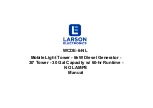
(see page 1 for location and additional information on the following switches)
S1
A) Setting of the Tachometer Matching Switch.
- The Motor Nameplate lists the Tachometer information in the following format;
“ 3 ~ 1FU10 . . - 6 . . nn.n mVmin” which is millivolts per RPM. Multiply “nn.n” times the maximum(rated)
Motor RPM(i.e..; C = 2000 RPM, F = 3000 RPM, etc..). If the result is = 40, leave the switches open
(as received); if <= 16.5, close all three wire loops.
S2
B) Bit 1: Sets Motor Direction Vs. Polarity of Command Voltage at X331, Term.’s 56 & 14
Bit’s 2, 3, 4 & 5: Sets Current Limit(Maximum allowable output current) for the Module.
Bit’s 6, 7, 8, & 9: Sets Current Loop Proportional Gain
-Determine this Axis’ Motor Type and Module Rating. Find the “Adaptation Table” for this Module in the
Installation Guide. Go down the first column until you find the appropriate motor. Follow this row across the
page to the right and under the column “Current Limit” you will find the settings for Bit’s 2, 3, 4 & 5. Under the
column “Current Gain” you will find the settings for Bit’s 6, 7, 8 & 9. Set contacts 2 through 9 as indicated.
Bit 10: Sets Drive to operate in “Velocity”(off) or “Torque(current)”(on) Mode
S3
C) The settings on this switch are normally left as received usless required to be changed. Changes are usually
necessary in cases where a module is being replaced or where experience with previous similar machines dictates
it. See page 1 for functions, pre-settings and switch locations.
4) Presetting is now complete. Re-Install the Controller PCB into the module, being careful to align it in the card
guides and to “seat” it firmly into the rear connector. Firmly tighten retaining screws “a” and “b”.
5) The following is a brief discussion of the adjustments;
“Drift”
This adjustment minimizes motor rotation with a “0 V” command when in velocity loop. In this mode it is impossible
to guarantee no rotation. When the drive is part of a “Position Loop”, this adjustment can assist in minimizing the
“Standing(Zero Speed) Following Error” in the higher order controller(CNC, etc..).
The Tachometer adjustment(range about 0.7 . . . 2.2
n
RATED
)
is used in velocity loop mode to scale the motor speed with
reference to the voltage applied to the Speed Command input terminals 56 & 14. In “Position Loop” mode it’s effect
will be to change the following error when running at speed.
“K
P
” & “T
N
”
Definitions: “K
P
” is the Proportional Gain and “T
N
” is the Integral Gain of the Velocity Loop.
Preset both adjustments(Axis 1-top and Axis 2-bottom) to 1 / 3 Scale.
After Power Up(and terminals 663 & 65 on this module have been enabled) the motor should have power applied to it.
These adjustments can then be used to match the servo axis performance to the requirements of the machine and the
higher order controller(CNC, etc..) if used. They should also be adjusted for optimum operation if used in Velocity
Loop mode . In may cases the preset adjustment value may be adequate for acceptable operation.
“AD”
Definition: “Low Speed Adaptation”, This adjustment is not functional unless S3 bit 5 is on.
If activated, AD provides a higher(faster) value of “T
N
”
to be active at very low speeds.
6) At this point this portion of the Drive System may be Powered Up and final tuning, etc., accomplished. Power
Up with terminals 663 and 65 open(not enabled). When enabling 663 and 65 for the first time use caution
as the motor may turn. Make sure all safety precautions have been taken. DO NOT RECONNECT OR
DISCONNECT WIRES OR CONNECTIONS
UNLESS POWER IS OFF AND DC LINK HAS DISCHARGED !
Pg. 3/ 3
611-A Servo Feed Module(1-Axes Standard Version)
Basic Start Up Procedure
NOTES:
These Steps are REQUIRED prior to powering up the motor. Installation Guide 6SN1197-0AA60-0BP3
is required for this procedure. The following steps assume the DC Link Power Source(I / R Module)
is already operational. All Power should be off prior to initiating this procedure. It is also assumed
that the this procedure is being performed by an individual with previous Servo System experience.
DC Link Power may take some minutes to drain down to a safe level after Power Off.
1) Isolate Modules to the right of this one(if they have not been made operational) by removing the Ribbon Connector
that is inserted into this module and opening the DC Link connection “links” to the next Module.
2) Remove the Controller PCB and Front Panel by loosening captive screws “a” and “b”(see page 2) and slowly pulling
the assembly out of module.
3) Presetting the Controller(s);
Max.
Min.
1/3
T
( 6 / 10 / 96 )
SECTION F
1-174
Summary of Contents for SIMODRIVE 611A
Page 2: ......
Page 6: ......
Page 7: ...SECTION 0 PRELIMINARY INFORMATION 0 7 ...
Page 8: ......
Page 17: ...Section 1 611A Analog Feed Drives 1 17 ...
Page 18: ...1 18 ...
Page 24: ...1 24 ...
Page 39: ...1 39 ...
Page 70: ...1 70 ...
Page 119: ...1 119 ...
Page 120: ......
Page 123: ......
Page 131: ......
Page 158: ...1 158 ...
Page 159: ...1 159 MOUNTING DIMENSIONS ...
Page 160: ...1 160 ...
Page 186: ......
Page 187: ...GENERAL INFORMATION REGARDING AC SERVO MOTORS AL S ...
Page 188: ......
Page 225: ...1FT5 AC SERVO MOTOR DESCRIPTIONS 1FT5 ...
Page 226: ......
Page 321: ...FEEDBACK DEVICES FOR 1FT5 GE ...
Page 322: ......
















































